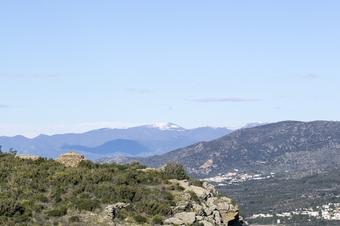
Introduction
The terraces, huts, farm walls and tracks speak to us of a prosperous past, a land that was worked and widely cultivated with vineyards and olive groves. The stones taken from the rocky ground meant there was sufficient raw material for the construction of these buildings which, after the arrival of the phylloxera, fell mostly into disuse.
The building technique used is known as dry stone and consists of placing the stones in rows without using any material to bind them together. The stones used are sourced from the same place and are not usually shaped or worked. In this area, the soil is stony and the cultivation of new areas for crops provided stones in abundance for the peasants..
The huts were built on those farmsteads that were far from the village in order to store tools or provide shelter in case of bad weather. What we have before us is a truncated conical type hut with a retaining ring to reinforce it. It retains the false vault, crowned with a movable slab so that the smoke could escape when there was a fire burning inside.
